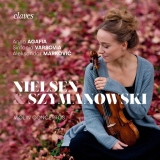Die junge Geigerin Anna Agafia hat im Vorjahr den Prix Thierry Scherz beim Festival des Sommets Musicaux de Gstaad gewonnen und damit verbunden eine CD-Einspielung. Dafür hat sie die Werke von Nielsen und Szymanowsky gewählt, bei denen sie gleichermaßen die Verbindung von himmlischen und bodenständig-volkstümlichen Elementen sieht, die beide Konzerte kennzeichnet. Daneben meint sie, dass beide Werke zu selten aufgeführt werden. Im Beiheft wird die Entwicklung der Künstlerin ausgiebig dargestellt.
Der Geigerin gelingt es bei Nielsen wunderbar, die Stimmungen des sich aus dem Licht nördlicher Breiten ergebenden Atems mit lebensfrohem Gestus und fein abgestimmten Ton zu charakterisieren. Der Lichteinfall der Sonne ist im Sommer lang und lässt Farben frisch leuchten, aber er ist nicht grell und blendet nicht. Insofern gibt sie ihrem Spiel eine weiche Note, die deswegen aber nicht bedrückt oder zurückgenommen erklingt. Vielmehr ist ihr klares und makelloses Spiel durch fröhliche Präsenz bestimmt. Und sie weiß den Reichtum musikalischen Ausdrucks zu vermitteln.
Die positive Stimmung bei Szymanowski speist sich aus den volkstümlichen Melodien der Goral, einer in der Tatra lebenden Volksgruppe. Hier bietet Agafia ein etwas robusteres Idiom an, dass aber immer noch durch ihre Handschrift geprägt ist und elegant gestaltet wird. Etwa in der in den beiden Sätzen eingelagerten Kadenz von Paul Kochanski und auch im Kehraus des Finales kommen Spielfreude und kräftigere Attacke zu ihrem Recht.
Die Sinfonia Varsovia bietet mit Aleksandar Markovic als Dirigent einen sensuell aufmerksamen Begleiter, der der Solistin den Vortritt lässt, aber sich durchaus auch mit packendem Zugriff zu positionieren weiß.
The young violinist Anna Agafia won the Prix Thierry Scherz at the Festival des Sommets Musicaux de Gstaad last year, and with it a CD recording. For this she chose the works of Nielsen and Szymanowsky, in which she sees equally the combination of celestial and down-to-earth folk elements that characterize both concertos. In addition, she feels that both works are too rarely performed. The booklet extensively describes the artist’s development.
In Nielsen’s work, the violinist succeeds wonderfully in characterizing the moods of the breath resulting from the light of northern latitudes with a lively gesture and finely tuned tone. The incidence of light from the sun is long in summer and makes colors glow freshly, but it is not glaring or blinding. In this respect, she gives her playing a soft note, but it does not sound depressed or withdrawn because of this. Rather, her clear and flawless playing is defined by a joyful presence. And she knows how to convey the richness of musical expression.
Szymanowski’s positive mood is fed by the folk melodies of the Goral, an ethnic group living in the Tatra Mountains. Here Agafia offers a somewhat more robust idiom, but one that is still marked by her signature and elegantly shaped. For example, in the cadenza by Paul Kochanski interspersed in the two movements, and also in the sweep of the finale, joy of playing and more vigorous attack come into their own.
With conductor Aleksandar Markovic the Sinfonia Varsovia offers a sensitively attentive accompaniment. Markovic gives the soloist the lead, but also knows how to position himself with gripping access.
























